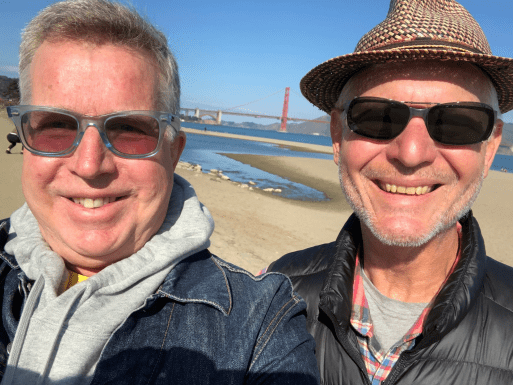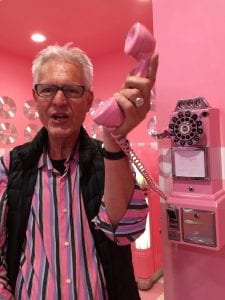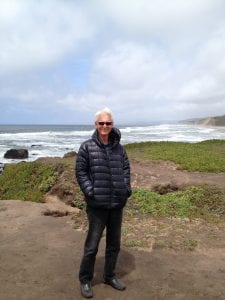
Jim Van Buskirk (right) and partner enjoying an outing in their home base of San Francisco
Jim Van Buskirk, a librarian, writer, editor, curator, and speaker, has dedicated his life to documenting and protecting the people’s history. Born in Los Angeles, California, Van Buskirk moved to San Francisco in 1972 where he has spent the last five decades as a cornerstone in the arts and humanities community, developing the James C. Hormel Gay & Lesbian Center at the San Francisco Public Library and documenting and presenting on topics primarily related to Jewish, queer and film history in the Bay Area and beyond.
It was only natural his interests in increasing awareness about all facets of life would lead him to explore all things death. Death Cafes — casual group settings where people, often strangers, gather to “eat cake, drink tea, and discuss death,” first came on the scene in the United Kingdom in 2011. It wasn’t long before the concept made its way to the Bay Area, where Van Buskirk became involved, co-hosting monthly gatherings at the Potrero Branch Library (held virtually for now).
It was here that he became involved in the right-to-die movement, by way of the nonprofit organization Final Exit Network. The right-to-die movement has been around since the 1970s; currently, eight states plus Washington, D.C. have approved medical aid in dying legislation. The majority of right-to-die legislation states that those who have been diagnosed with six months or less to live can, in theory, exercise some control over the time and manner of their deaths, usually with the approval of two separate physicians.
This leaves a large swath of the population without access to what the Final Exit Network holds to be a basic human right — the right to end one’s life when faced with intolerable suffering or pain. It is these folks that the Final Exit Network and Jim Van Buskirk, as a regional coordinator, hope to help through support and education of self-deliverance: the safe, certain, and peaceful act of killing oneself.
Editor’s note: This interview has been edited for length and clarity
Hi! Lovely to meet you! Before we dive into your story, I see that “self-deliverance” is the key phrase used by Final Exit Network when it comes to taking one’s life — is that preferable or is rational suicide also okay?
Self-deliverance is what [FEN] prefers to use; I think “suicide” itself is an appropriate word, but it’s our attitudes around it that are the issue.
I tend to agree with you on that. What brought you to the work you do with Death Cafes and the Final Exit Network?
A friend asked me if I knew about Death Cafes and I didn’t! At the time, it was in Oakland, and I lived in San Francisco. We ended up getting stuck in traffic and spent an hour on the bridge. I had already been facilitating some groups, and I thought, instead of spending all this time on the bridge, why don’t we do this ourselves, in our community?
All we needed was a space, and as a former librarian I knew about the Potrero Branch Library. Under their policy, we could use the space once a month for a year, and that’s how we got started. People showed up, and it was amazing — turns out, people had been starving to talk about this stigmatized topic. So we just started doing it regularly.

One of the women who came regularly was talking about her diminished sight and diminished cognition and she told me that she had contacted the Final Exit Network, and that the guides were coming, and she wanted me there with her.
I said yes, but I didn’t know what it meant.
I spoke to the Final Exit Network volunteers by phone before going, and they explained the process and assured me that everything they were doing was legal. So, I went, and the guides were there and I was very impressed with the entire process — I signed up and I wrote an article about my experience and it ended up in their newsletter. It said, in part —
“The FEN volunteers arrived precisely at 2:30 as planned and I marveled at how patient, knowledgeable, and personable they both were. Because M could scarcely see, I read out the checklist of items, while M impatiently agreed to each one. She articulated why she was intent on self-deliverance, reiterated that she knew exactly what she was doing, and was eager to carry out her task. We watched as she signed the document with determination. The volunteers then showed her how to assemble the equipment she’d ordered, instructing her step-by-step. Despite her requests, they repeatedly declined to actually do anything for her, insisting that she accomplish each task herself.
With persistence and a bit of frustration she assembled the hood, taping the plastic tube inside and securing the bottom with a headband. She connected the other end of the tube to the regulator which she’d screwed onto the canister…with no ceremony or final words, the three of us watched as M turned the dial, pulled down the hood, and began inhaling.
She closed her eyes as her breathing became shallow. One of the volunteers monitored her pulse. A few physical twitches and soon she was gone. She looked peaceful. It had been so sweet, simple, sad, and straightforward. I was moved by the simultaneously monumental and mundane moment of what we had witnessed.”
That article connected me with another woman who was interested in FEN, and we established a phone friendship over the course of several months. She asked me to be there for her exit, and I said yes.
After those two experiences, I was invited to be regional coordinator for Texas, Colorado, New Mexico, and Arizona … and that was almost two years ago.
Wow, that’s incredibly moving. So, what’s the added layer that Final Exit Network provides that medical aid in dying does not?
Final Exit Network views degenerative diseases such as ALS and Parkinson’s in a way that medical aid in dying does not. And not to besmirch the medical community, but a six-month prognosis for many things is a guess. They don’t know for sure, so it doesn’t seem right to hold people to that number.
It’s interesting to look at the statistics, though … not everyone who applies and gets accepted for the medical aid in dying uses it. They’re happy to have it there on the nightstand, but they don’t necessarily use it. And I think that’s the point — it gives people a tiny feeling of control where they might not have any control.
A big part of FEN is just to make sure that people have someone who listens to them and isn’t afraid of what they’re saying — that can bring a great deal of comfort. Once, after a conversation about this with a 97-year-old woman and her 77-year-old daughter, her daughter told me she will never forget the look of calm and solace that she saw on her mother’s face. They may become a client and take part in the process, they may not, but I think just knowing they have options is a huge comfort.
It does seem very empowering for the person making that decision. What do you do as regional coordinator?
Anyone who contacts us via email or phone, I call them back and ask about their situation. Sometimes it’s just people who want to renew their membership; others are people who I talk to for months. I establish relationships with them and get to know them.
And once someone makes the decision to pursue self-deliverance, what is the process?
It’s rigorous but straightforward. First, we find out what their prognosis is, and that needs to be supplemented with medical records. That information is sent to me, and I arrange for an interviewer to find out things such as, “What’s your living situation like? Who has keys? How often do people come by unannounced? Who knows what about what you want?” This is to get a clearer picture as we move forward.
I take all those pieces of information and share it with our medical evaluation committee and they make a determination. This is either, “I’m sorry, this person is not accepted” or “We need this additional test or report” or “Yes, this person is accepted for exit guide assignment.” If accepted, I assign a guide who’s located in their area, or available to travel there. They contact the person, they ask some additional questions, and if they don’t see any red flags, we go to the next step, which is letting the person know what they need to acquire.
What are some “red flags”? I read that FEN cannot accept applicants whose primary medical complaint is mental illness, which makes sense as that seems like a fairly grey area. What are some other red flags?
I had one case where the exit guide was working with someone who had a fairly dysfunctional family. Some important conversations needed to happen, but she couldn’t make the phone calls, and so finally the guide had to make the difficult decision to not move forward. It was putting the organization at risk — and as a guide there is considerable risk management. We have to do that so that we can continue to support people. We’ve had at least three court cases, and are very careful to stay within each jurisdiction’s legal requirements.
“One thing is troubling me … it makes me angry and sad that I’ve had to do all of this in such secrecy.”
What are some of those legal requirements?
Guides never provide the means and never provide active physical “assistance” for self-deliverance. We’re not endorsing anything, we just provide information and education so that people have a full understanding of their options, as well as what the pros and cons of each modality might be.
It is complicated, but FEN has really good legal counsel to ensure that we stay within the law. Each state is different — it’s less what’s on the books, and more about who’s involved. Each case, from start to finish, from the very first phone call to the exit, is completely unique. Some people have a wonderfully supportive family; others not at all. Some people are totally isolated.
 Such was the case with the second woman whose exit I was present for. When I was there, I asked her how she was feeling, and she said, “One thing is troubling me … it makes me angry and sad that I’ve had to do all of this in such secrecy.”
Such was the case with the second woman whose exit I was present for. When I was there, I asked her how she was feeling, and she said, “One thing is troubling me … it makes me angry and sad that I’ve had to do all of this in such secrecy.”
And I thought that was such a shame and that it shouldn’t be someone’s last thought. But it’s true, everything had to be done discretely, and that’s to protect her and the organization.
For example, one woman told her friends about what she wanted to do. And then they took it upon themselves to call the police. I’ve talked to people who have been halfway through whatever modality they choose and they’re interrupted. That’s why it’s key, and it’s one of the things we teach, that whatever modality you choose to use, you need to make sure you are going to be 100 percent successful. You don’t want any mishaps — that is everything you’re trying to avoid.
What are some of the recommended modalities or recommended resources to learn more?
The Peaceful Pill Handbook is a great resource that ranks every modality across a number of elements, including availability, harm to others, speed, safety, and so on. Another resource we recommend is Final Exit by Derek Humphrey, which details using inert gas to bring a peaceful end to life. This is the method FEN supports, described in my experience for the two rational suicides I was present for. A new eBook version was released in 2020.
For those who are interested in getting involved with the Final Exit Network, what would you recommend they do?
There are a lot of different ways. I’m a coordinator. I took the exit guide training and I decided that wasn’t something I wanted to pursue. We have writers, speakers, guides, coordinators, physicians, just all kinds of opportunities. The best things would be to familiarize yourself with the organization and the website, and then to contact them, let them know your skills and see what they need.
The exit guide training is offered every two to three years. One starts off as an associate guide, goes with a senior guide until you receive a certain level of expertise, and then you become senior guide. It’s a whole mentorship process, because the one thing we want to make sure is that people are comfortable and confident, and there are no problems.
I’ve worked for a number of organizations, and the team here is really conscientious and wonderful to work with. These people are dedicated, committed and compassionate — many of them have been in it for decades, and then there are those newbies like me, and we’re such a great team. I’m so impressed with everyone I’ve met. Nobody says, “Well, that’s your client, you deal with it.” Everyone is committed to working to get people what they want. It’s really amazing.
Thank you so much for taking the time to talk to me about this fascinating topic and the work that Final Exit Network does.

 When Medical Aid in Dying Isn’t an Option, Where Can Suffering People Turn For Help?
When Medical Aid in Dying Isn’t an Option, Where Can Suffering People Turn For Help?


 “Help Me, Helen”
“Help Me, Helen”
 Recovering Cremation Remains After the Los Angeles Fires
Recovering Cremation Remains After the Los Angeles Fires
 “As Tears Go By” by Marianne Faithfull
“As Tears Go By” by Marianne Faithfull














